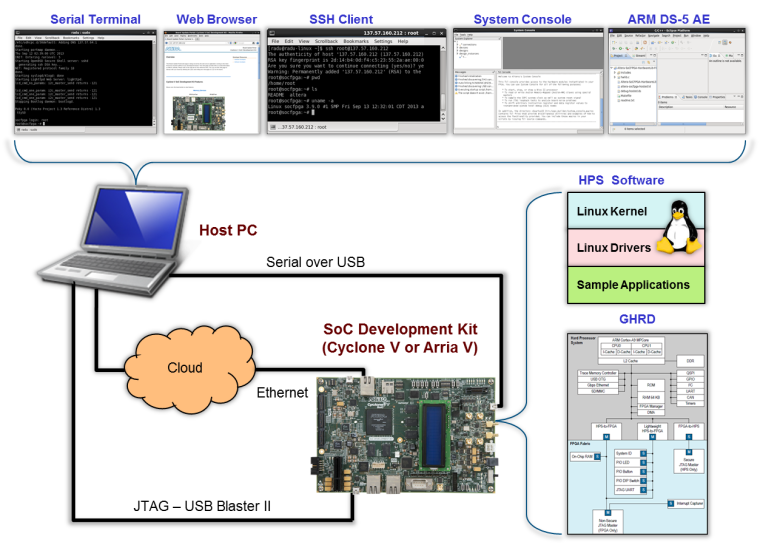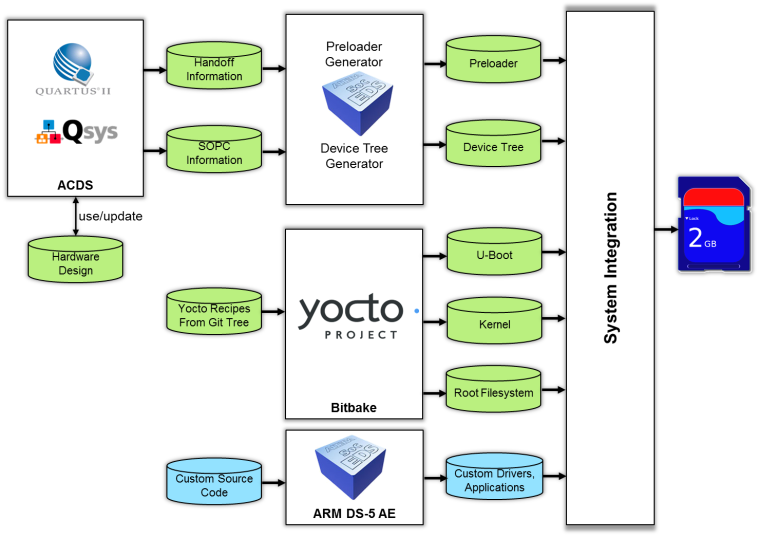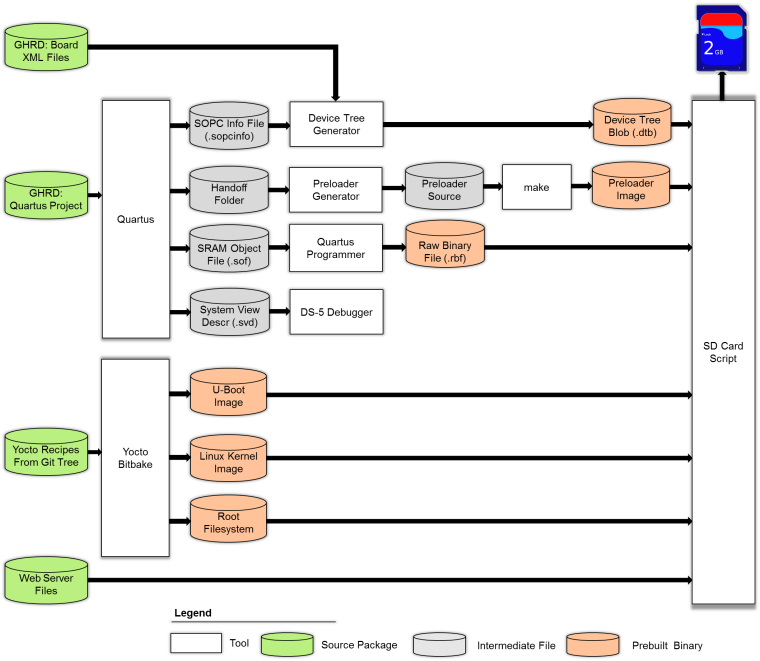Introduction
The
Golden System Reference Design (GSRD) User Manuals (Golden System Reference Design) provides a set of essential hardware and software system components that can be used as a starting point for various custom user designs.
Getting Started Guides
Cyclone V Getting Started Guides
Arria V Getting Started Guides
The
Golden System Reference Design (GSRD) User Manuals consists of:

Release Notes
See
Release Notes.
Release Contents
See
Release Contents.
Release Location
The
Golden System Reference Design (GSRD) User Manuals 14.1 Release is available at
https://releases.rocketboards.org/2014.12.
Prerequisites
The following are required in order to be able to fully exercise the
Golden System Reference Design (GSRD) User Manuals:
Default Paths
Throughout the documentation, the following default paths are assumed. Please update the commands accordingly if non-standard paths are used.
| Default Path |
Description |
|---|
| ~/altera/\/embedded |
SoC EDS installation path |
| ~/altera/\/qprogrammer |
Quartus II Programmer installation path |
| ~/altera/\/quartus |
Quartus II installation path |
| ~/cv_soc_devkit_ghrd |
Cyclone V GHRD folder, extracted from cv_soc_devkit_ghrd.tar.gz |
| ~/av_soc_devkit_ghrd |
Arria V GHRD folder, extracted from av_soc_devkit_ghrd.tar.gz |
GHRD Overview
See
GHRD Overview.
HPS Boot Flow
See
HPS Boot Flow.
Development Flow Overview
The following picture presents a high level view of the development flow for projects based on the
Golden System Reference Design (GSRD) User Manuals.

The following diagram illustrates the full build flow for the
Golden System Reference Design (GSRD) User Manuals.

The following table presents the tools that are used in the build flow:
| Tool |
Description |
Part of |
|---|
| Quartus II |
Create, edit and compile FPGA hardware designs |
ACDS |
| Device Tree Generator |
Generate Device Trees |
SoC EDS |
| Device Tree Compiler |
Converts between Device Tree file formats |
^ |
| Preloader Generator |
Generates Preloader source code based on hardware handoff information |
^ |
| ARM DS-5 AE |
Software Development Suite |
^ |
| Bitbake |
Yocto build utility |
Yocto Source Package |
| SD Card Script |
Script that creates the SD card image |
^ |
The following table presents the input files that are part of the build process:
| File |
Description |
|---|
| Quartus Project |
FPGA Hardware Project source code |
| Board XML Files |
File describing the development board, used in creating the Device Tree |
| Yocto Recipes |
Yocto recipes for building the Linux deliverables |
| Web Server Files |
Additional files needed for the web server running on the board |
The following table describes the rest of the items that are part of the build flow diagram:
| File |
Description |
|---|
| .sof |
SRAM Object File - FPGA programming file, resulted from compiling the FPGA hardware project |
| .rbf |
Raw Binary File - Compressed FPGA programing file |
| .dts |
Device Tree Source - used to describe the hardware for the Linux kernel |
| .dtb |
Device Tree Binary - binary representation of the .dts |
| .sopcinfo |
SOPC Info File - containing a description of the hardware to be used by Device Tree Generator |
| .svd |
System View Description File - describes the hardware for the DS-5 debugger |
| Handoff |
Folder containing a description of the hardware to be used by the Preloader Generator |
Not all the people involved in a project need to deal with the full flow. For example:
- Board Designer: Typically works with the hardware engineer to decide the design of the custom board, pin muxing, and to update the Board XML file used by the Device Tree Generator.
- Hardware Engineer: Usually works only on the FPGA Quartus Project, and notifies the firmware engineer whenever the hardware files (.sof, .rbf, .sopcinfo, handoff folder) were changed. He also needs to notify the firmware engineer of any hardware interface changes.
- Firmware Engineer: Typically updates the Linux drivers according to the changes that were performed in hardware, recompiles the kernel if necessary. Re-generates the Device Tree when needed.
- Software Engineer: Develops the applications that run on top of the Linux OS. May need to change the software when new drivers are added.
Linux Documentation
 Macnica Sulfur ~ Development Kit for Agilex™ 5 FPGA E-Series ~
Macnica Sulfur ~ Development Kit for Agilex™ 5 FPGA E-Series ~
 Building Bootloader for Agilex 5
Building latest bootloaders for Agilex 5 SoC Devices
Building Bootloader for Agilex 5
Building latest bootloaders for Agilex 5 SoC Devices GSRD for Agilex 7 I-Series Transceiver-SoC DevKit (4x F-Tile)
Golden System Reference Design for DK SI AGI027FB, DK SI AGI027FA and DK SI AGI027FC
GSRD for Agilex 7 I-Series Transceiver-SoC DevKit (4x F-Tile)
Golden System Reference Design for DK SI AGI027FB, DK SI AGI027FA and DK SI AGI027FC

 The following table presents the tools that are used in the build flow:
The following table presents the tools that are used in the build flow:  RocketBoards
RocketBoards